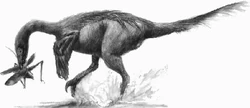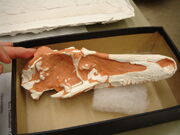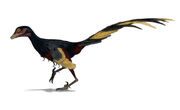| Troodontids Fossil range: Late Jurassic–Late Cretaceous | |
|---|---|
 | |
| Scientific classification
| |
|
Class |
|
|
Superorder |
|
|
Order |
|
|
Suborder |
|
|
Infraorder |
|
|
Family |
|
|
See text. | |
|
| |
Troodontidae is a family of bird-like theropod dinosaurs. During most of the 20th Century, troodontid fossils were few and scrappy and they have therefore been allied, at various times, with nearly every major coelurosaurian lineage. More recent fossil discoveries of complete and articulated specimens, (including specimens which preserve feathers, eggs and embryos, and complete juveniles) have helped to increase understanding about this group. Anatomical studies, particularly studies of the most primitive troodontids, like Sinovenator, demonstrate striking anatomical similarities with Archaeopteryx and primitive dromaeosaurids, and demonstrate that they are relatives comprising a clade called Paraves.
Physical characteristics[]
Troodontids were a group of small- to medium-sized theropods (~1-100 kg) with unusually long legs compared to other theropods, with a large, curved claw on their retractable second toes, similar to the "sickle-claw" of the dromaeosaurids. However, the sickle-claws of troodontids were not as large or recurved as in their relatives, and in some instances could not be held off the ground and "retracted" to the same degree. In at least one troodontid, Borogovia, the second toe could not be held far off the ground at all and the claw was straight, not curved or sickle-like.

Skull of the troodontid Saurornithoides mongoliensis.
Troodontids had unusually large brains among dinosaurs, comparable to those of living flightless birds. Their eyes were also unusually large, and pointed forward, indicating that they had very strong, binocular vision. The ears of troodontids were also unusual among theropods, having extremely enlarged middle ear cavities, indicating acute hearing ability. The placement of this cavity near the eardrum may have aided in the detection of low-frequency sounds.[1] Troodontid ears were also asymmetrical, with one ear placed higher on the skull than the other, a feature shared only with some owls. The extreme specialization of the ears may indicate that troodontids hunted in a manner similar to owls, using their hearing to locate small prey.[2] Although most paleontologists believe that they were predatory carnivores, the many small, coarsely serrated teeth and U-shaped jaws of some species (particularly Troodon) suggest that some species may have been omnivorous or herbivorous.[3] In contrast, a few species, such as Byronosaurus, had large numbers of needle-like teeth, which seem best-suited for picking up small prey, such as birds, lizards and small mammals.
Paleobiology[]
Many troodontid nests, including eggs that contain fossilized embryos, have been described. Hypotheses about troodontid reproduction have been developed from this evidence (see Troodon, "Reproduction").
A few troodont fossils, including specimens of Mei and Sinornithoides, demonstrate that these animals roosted like birds, with their heads tucked under their forelimbs.[4] These fossils, as well as numerous skeletal similarities to birds and related feathered dinosaurs, support the idea that troodontids probably bore a bird-like feathered coat. The discovery of a fully-feathered, primitive troodontid (Jinfengopteryx) lends support to this.
In 2004, Mark Norell and colleagues described two partial troodontid skulls (IGM 100/972 and IGM 100/974) found in a nest of oviraptorid eggs in the Djadokhta Formation of Mongolia. The nest is quite certainly that of an oviraptorosaur, since an oviraptorid embryo is still preserved inside one of the eggs. The two partial troodontid skulls were first described by Norell et al. (1994) as dromaeosaurids, but reassigned after further study.[5] The troodontids were either hatchlings or embryos, and fragments of eggshell are adhered to them although it seems to be oviraptorid eggshell. The presence of tiny troodontids in an oviraptorid nest is an enigma. Hypotheses explaining how they ended up in an oviraptorid nest include that they were the prey of the adult oviraptorid, that they were there to prey on oviraptorid hatchlings, or that some troodontids may have been nest parasites.[6]
Troodontids and bird evolution[]

The troodontid Jinfengopteryx elegans was originally classified as a bird related to Archaeopteryx.
Troodontids are important to research on the origin of birds because they share many anatomical characters with early birds. Crucially, the substantially complete fossil identified as WDC DML 001 ("Lori"), is a troodontid from the Late Jurassic Morrison Formation, close to the time of Archaeopteryx. The discovery of this Jurassic troodont is positive physical evidence that derived deinonychosaurs were present very near the time that birds arose, and basal paravians must have evolved much earlier. This fact strongly invalidates the "temporal paradox" cited by the few remaining opponents of the idea that birds are closely related to dinosaurs.
Systematics[]
Troodontid fossils were among the first dinosaur remains ever described. Initially, Leidy (1856) assumed they were lacertilian (lizards), but, by 1924, they were referred to Dinosauria by Gilmore, who suggested that they were ornithischians. It wasn't until 1945 that C.M. Sternberg recognized Troodontidae as a theropod family. Since 1969, Troodontidae has typically been allied with Dromaeosauridae, in a clade (natural group) known as Deinonychosauria, but this was by no means a consensus. Holtz (in 1994) erected the clade Bullatosauria, uniting Ornithomimosauria (the "ostrich-dinosaurs") and Troodontidae, on the basis of characters including, among others, an inflated braincase (parabasisphenoid) and a long, low opening in the upper jaw (the maxillary fenestra). Features of the pelvis also suggested they were less advanced than dromaeosaurids. New discoveries of primitive troodontids from China (such as Sinovenator and Mei), however, display strong similarities between Troodontidae, Dromaeosauridae and the primitive bird Archaeopteryx, and most paleontologists, including Holtz, now consider troodontids to be much more closely related to birds than they are to ornithomimosaurs, causing the clade Bullatosauria to be abandoned.
The most intensive study of theropod systematics by members of the Theropod Working Group [2] has uncovered striking similarities among the most basal dromaeosaurids, troodontids, and Archaeopteryx. This clade is together called Paraves by Novas and Pol.[7] The cladogram published in Hwang et al. found that Archaeopteryx represents a more basal branch of Paraves, and places dromaeosaurids and troodontids as more derived. This raises the possibility that aerodynamic behaviors could be ancestral to all Deinonychosauria.[8]
Taxonomy[]
- Family Troodontidae
- Borogovia
- Byronosaurus
- Jinfengopteryx
- ?Koparion
- Mei
- Saurornithoides
- Sinornithoides
- Sinusonasus
- Sinovenator
- Tochisaurus
- Troodon
- Urbacodon
- Zanabazar
- Undescribed/unnamed specimens
- IGM 100/972 and IGM 100/974
- SPS 100/44 = EK troodontid
- WDC DML 001 ("Lori")
Phylogeny[]
The cladogram below follows a 2007 analysis by Turner and colleagues.[9]
| Troodontidae |
| |||||||||||||||||||||||||||||||||||||||
References[]
- ^ Currie, P. J. (1985). "Cranial anatomy of Stenonychosaurus inequalis (Saurischia, Theropoda) and its bearing on the origin of birds." Canadian Journal of Earth Sciences, 22: 1643-1658.
- ^ Castanhinha, R., and Mateus, O. (2006). "On the left-right asymmetry in dinosaurs." Journal of Vertebrate Paleontology, 26 (Supp. 3): 48A.
- ^ Holtz, T.R., Jr., Brinkman, D.L. and Chandler, C.L. (1998). "Denticle morphometrics and a possibly omnivorous feeding habit for the theropod dinosaur Troodon." Gaia, 15: 159-166.[1]
- ^ Xu and Norell, (2004). "A new troodontid dinosaur from China with avian-like sleeping posture." Nature, 431: 838-841.
- ^ Mackovicky, Peter J.; and Norell, Mark A. (2004). "Troodontidae". in Weishampel, David B.; Dodson, Peter; and Osmólska, Halszka (eds.). The Dinosauria (2nd ed.). Berkeley: University of California Press. pp. 184–195. ISBN 0-520-24209-2.
- ^ Norell, Mark A.; Clark, James M.; Dashzeveg, Demberelyin; Barsbold, Rhinchen; Chiappe, Luis M.; Davidson, Amy R.; McKenna, Malcolm C.; Perle, Altangerel; and Novacek, Michael J. (November 4 1994). "A theropod dinosaur embryo and the affinities of the Flaming Cliffs dinosaur eggs". Science 266 (5186): 779–782. doi:. PMID 17730398.
- ^ Novas, F. E. & Pol, D. (2005). "New evidence on deinonychosaurian dinosaurs from the Late Cretaceous of Patagonia." Nature, 3285: 858-861.
- ^ Hwang, S.H., M.A. Norell, Q. Ji, and K.-Q. Gao. (2002). "New specimens of Microraptor zhaoianus (Theropoda: Dromaeosauridae) from Northeastern China." American Museum Novitates, 3381: 1–44.
- ^ Turner, Alan H.; Pol, Diego; Clarke, Julia A.; Erickson, Gregory M.; and Norell, Mark (2007). "A basal dromaeosaurid and size evolution preceding avian flight" (pdf). Science 317: 1378–1381. doi:. PMID 17823350. http://www.sciencemag.org/cgi/reprint/317/5843/1378.pdf.